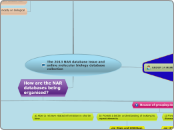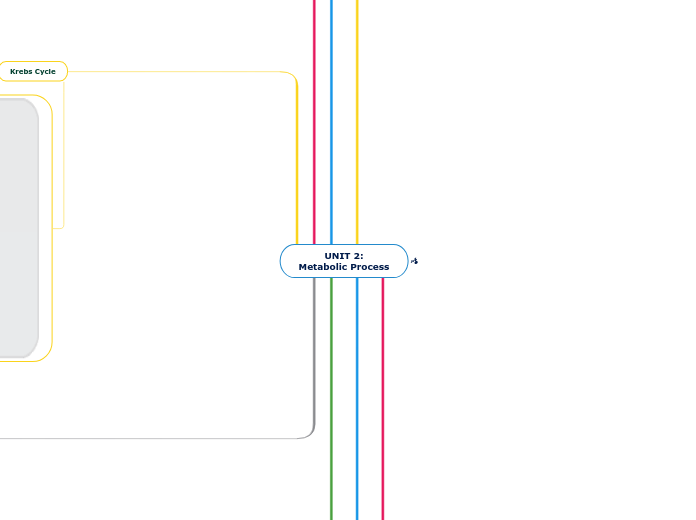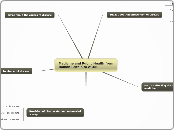REFERENCES:
http://bioinformatics.oxfordjournals.org/content/24/19/2127.abstract
http://nar.oxfordjournals.org/content/40/D1/D1250.short
Daniel J. Rigden, Xosé M. Fernández-Suárez, and Michael Y. Galperin
The 2016 database issue of Nucleic Acids Research and an updated molecular biology database collection
Nucl. Acids Res. (04 January 2016) 44 (D1): D1-D6
GROUP 10.
1.WAN MULIATI BT WAN ZAINAL ABIDIN.
2.NUR FITRI BT ISMAIL.
3.NAJIHA BT MOHD NOH.
4.NUR HAFIZAH BINTI ABDUL HALIM
5.SITI AISHAH BT ABD RAHMAN.
NAR DATABASES
Why some databases are no longer in the databases and dropped from it?
-The ExDom database of exon-intron structures of genes in seven eukaryotic genomes had been removed as it does not provide a free version anymore due to the tightening budget.
-The databases are have highly specialized data and/or narrow target audience.
-Limited access to only to the registered users for example Human Gene Mutation Database (HGMD).
-Most of the citation in the databases duplicated the same data by the same authors.
-The function of previous databases differed from time to time and have been replaced with new databases that are updated for example Families of Structurally Similar Proteins (FSSP) database was superseded by the Dali database.
. NUMBER OF DATABASES AVAILABLE
1685 Databases
23 obselete websites.
88 new resources
2016 UPDATED ONLINE MOLECULAR BIOLOGY DATABASES COLLECTION
Others
MitoCarta,
MitoMiner,
MitoAge.
Databases of mitochondria protein and properties.
CSDB,
GlyToucan.
Glycoinformatics resourses.
NCBI's PubChem,
EBI's ChemBI,
SureChemBL.
Databases of chemical, small compounds.
Plants
PlantPromoter Analysis Navigator,
1C4R.
Human Disease and Drugs
DIDA
Collect data on diseases such as Bardet-Biedl and Kallmann syndromes.
ClinVar,
GWASdb,
HaploREG.
Human genetic variation as it relates to disease.
Genome of Human and Model Organisms.
dbMAE
Databases of autosomal monoallelic gene expression.
DMDD
Collect phenotypic data of mouse mutant embryos.
Ensembl, RefSeq, UCSC Genome Browser,
FlyBase, ENCODE Portal Hymenoptera.
Human and model organisms genome resources.
Viruses, Bacteria, Protozoa,Fungi
BacWGST
Bacterial whole-genome sequence typing database.
MG-RAST,
EBI Metagenomics,
probeBASE,
Human Pan-Microbe communities.
Updates on popular metagenomics resources.
BacDive
Coverage of organismal diversity.
KEGG, MetaCyc, Reactome, WikiPathways,
ECMDB, BIGG Models, MNXref, MetaNETX,
Metabolomics Workbench.
Databases of all kinds of metabolomics data, ex: protocols, tutorial and analysis tools.
Protein Sequence and Structure
PDBs, PDBFlex.
Protein structure database.
SORF, PRIDE,
dbPTM
Poteomics database.
ELM, NBDB,
UET.
Databases of protein sequence motifs.
MEROPS, Degradome
Databases of proteases and
proteases inhibitor.
pfam, PANTHER, eggNOG,
GPCRdb, TCDB.
Popular protein families databases
Nucleic Acid Sequence and Structure
BIGNAsim
Databases of DNA dynamics.
JASPAR,HOCOMOCO,ORegAnno,RegulonDB
Databases of transcriptional regulation
UTRs,NPIDB
Nuclear-protein interaction databases.
AREsite
Resource of Au-rich elements in vertebrates.
Dfam
Databases of human DNA repeat families.
dbSUPER, SEA
Collect the sequences of super-enhancer.
JuncDE
Databases of exon-exon junction sequences.
CEGA
A collection of non-coding sequences that are poorly characterized but highly conserved within various group
of vertebrates.
Why databases are created and shared.
Facilitate the viewer to obtain valuable resource for scientific research.
Entries can be searched, listed, browsed or queried. User-friendly.
Each entry is structured using templates and can carry various user comments and annotations.
There is a pressing need to store, share, organize, catalogue and rate the resources.
So that the information they contain can be most effectively exploited.
In the field of biology, make biological data are accessible
Provide an invaluable resource for the biological community.
Provide information that analyse, integrate and summarize the available data.
Increase in number of publicly available databases.
.WHY DATABASES NEED TO BE GROUP?
The increasing number of databases in the past decade
Provide the biologist user with the information about a link's context and narrow down the database best suited to their research need.
Allow biologist user to search what they need easily.
Biologist user do not have a comprehensive index of bioinformatics algorithm, databases and literature annotation.
Bioinformatics researchers having difficulties to track tools, information and method in field or even within the specialty area.
NAR ONLINE MOLECULAR BIOLOGY DATABASES COLLECTION.
Cell Biology.
•BARCdb
•BARD
•CloneDB
•NCBI Bookshelf
Immunological databases.
•ALPSbase
•AntigenDB
•AntiJen
•BCIpep
Plant databases.
•Chloroplast Genome Database
•General plant databases
•Arabidopsis thaliana
•Rice
Organelle databases.
•Chloroplast Genome Database
•FUGOID
•PLprot
•Mitochondrial genes and proteins
Other Molecular Biology Databases.
•PubMed
•BioModels
•Drugs and drug design
•Molecular probes and primers
Proteomics Resources
•2D-PAGE
•AAindex
•Open Proteomics Database
Microarray Data and other Gene Expression databases.
•CAGE
•CATMA - Complete Arabidopsis Transcriptome MicroArray
•CEBS
•CGED - Cancer Gene Expression Database
•Gene Expression Barcode
Human Genes and Diseases.
•CancerResource
•DriverDBv2
•Protein Mutant Database
•General human genetics databases
•General polymorphism databases
•Cancer gene databases
Human and other vertebrate Genomes.
•Model organisms, comparative genomics
•Human genome databases, maps and viewers
•Human ORFs
Metabolic and Signalling Pathways.
•ChemProt
•Prokaryotic genome databases
•Enzymes and enzyme nomenclature
•Metabolic pathways
•Protein-protein interactions
•Signalling pathways
Genomics databases.
•The Gene Indices
•Genome annotation terms, ontologies and nomenclature
•Taxonomy and identification
•General genomics databases
•Viral genome databases
•Prokaryotic genome databases
•Unicellular eukaryotes genome databases
•Fungal genome databases
•Invertebrate genome databases
Structure databases.
•BARD
•Small molecules
•Carbohydrates
•Nucleic acid structure
•Protein structure
Protein sequence databases.
•General sequence databases
•Protein properties
•Protein localization and targeting
•Protein sequence motifs and active sites
•Protein domain databases; protein classification
•Databases of individual protein families
RNA sequence databases.
•16S and 23S Ribosomal RNA Mutation Database
•3D rRNA modification maps
•dbRES
•CircNet
Nucleotide sequence databases.
•International Nucleotide Sequence Database Collaboration
•Coding and non-coding DNA
•Gene structure, introns and exons, splice sites
•Transcriptional regulator sites and transcription factors









